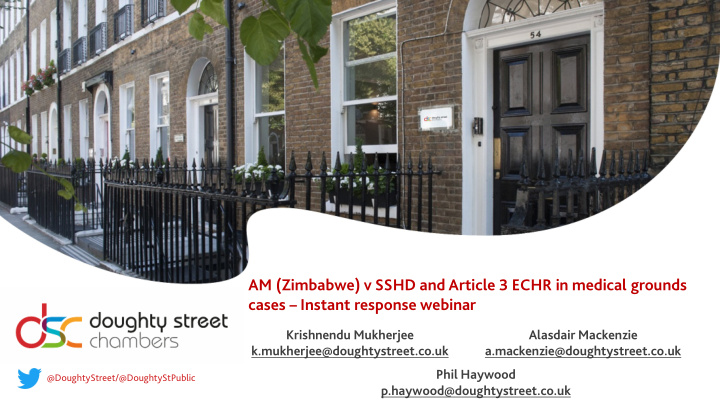



AM (Zimbabwe) v SSHD and Article 3 ECHR in medical grounds cases – Instant response webinar Krishnendu Mukherjee Alasdair Mackenzie k.mukherjee@doughtystreet.co.uk a.mackenzie@doughtystreet.co.uk Phil Haywood @DoughtyStreet/@DoughtyStPublic p.haywood@doughtystreet.co.uk
AM (Zimbabwe): the test D v UK : a ‘deathbed case’ N v UK : other ‘exceptional’ cases, unspecified but not including a situation where the outlook was thought to be uncertain Paposhvili v Belgium : “clarifying” N: §183: “the removal of a seriously ill person in which substantial grounds have been shown for believing that he or she, although not at imminent risk of dying, would face a real risk, on account of the absence of appropriate treatment in the receiving country or the lack of access to such treatment, of being exposed to a serious, rapid and irreversible decline in his or her state of health resulting in intense suffering or to a significant reduction in life expectancy.” t. 020 7404 1313 w. www.doughtystreet.co.uk
AM (Zimbabwe): the test A complex test raising a number of issues: i. ‘seriously ill’ ii. ‘substantial grounds for believing’ a risk exists, i.e. with evidence iii. ‘not at imminent risk of dying’ – so an addition to the “deathbed” cases; must mean ‘not at imminent risk of dying’ in the host country iv. ‘real risk’ of specified health consequences v. appropriate treatment in the receiving country needs to be: a) EITHER absent b) OR inaccessible (i.e. practically inaccessible to the individual concerned) vi. ‘on account of’ – so there must be a causal link between the lack of treatment and the health consequences vii. then: a) EITHER decline in health which – BOTH results in intense suffering – AND is • serious • rapid • irreversible b) OR significant reduction in life expectancy t. 020 7404 1313 w. www.doughtystreet.co.uk
PROCEDURAL ASPECTS OF PAPOSHVILI Paposhvili sets out a series of procedural requirements, which are a departure from earlier case law. Savran v Denmark (referred to the Grand Chamber in January 2020) is likely to give ‘clarification’. However Lord Wilson indicated that ‘Observations on them even now can be made with reasonable confidence’. Lord Wilson sets out the relevant framework at §23 : It was for applicants to adduce evidence “ capable of demonstrating that there are substantial grounds for believing ” [on account of ‘ the absence of appropriate treatment … or the lack of access to such treatment’ ] that, if removed, they would be exposed to a real risk of subjection to treatment contrary to article 3 [Paposhvili at §186]. The Applicant will need to produce evidence of his/her (a) medical condition; (b)current treatment; (c) suitability of alternative treatment; (d) effect of inability to access that treatment [cost; geographical location of treatment etc; where relevant, lack of family; follow up in the community to avoid relapse in mental illness etc.] ‘… irrespective of the perhaps unnecessary complexity of the test, let no one imagine that it represents an undemanding threshold for an applicant to cross. For the requisite capacity of the evidence adduced by the applicant is to demonstrate “ substantial” grounds for believing that it is a “very exceptional” case because of a “real” risk of subjection to “inhuman” treatment. All three parties accept that Sales LJ was correct … to describe the threshold as an obligation on an applicant to raise a “prima facie case” of potential infringement of article 3. This means a case which, if not challenged or countered, would establish the infringement’ [§32] t. 020 7404 1313 w. www.doughtystreet.co.uk
PROCEDURAL ASPECTS OF PAPOSHVILI If such evidence produced , then (as the state is better placed to collect evidence of likely availability and accessibility of treatment), it is for SSHD [§23 (b) – (d)] : • To “dispel any [serious] doubts raised by it”; to subject the alleged risk to close scrutiny; and to address reports of reputable organisations about treatment in the receiving state [§187]; • To “ verify on a case-by-case basis ” whether the care generally available in the receiving state was in practice sufficient to prevent the applicant’s exposure to treatment contrary to article 3; • The returning state also had to consider the accessibility of the treatment to the particular applicant , including by reference to its cost if any , to the existence of a family network and to its geographical location; [§190] • If, following examination of the relevant information, serious doubts continued to surround the impact of removal, the returning state had to obtain an individual assurance from the receiving state that appropriate treatment would be available and accessible to the applicant [§191]. t. 020 7404 1313 w. www.doughtystreet.co.uk
AM (Zimbabwe) v SSHD and Article 3 ECHR in medical grounds cases – Instant response webinar Krishnendu Mukherjee Alasdair Mackenzie k.mukherjee@doughtystreet.co.uk a.mackenzie@doughtystreet.co.uk Phil Haywood @DoughtyStreet/@DoughtyStPublic p.haywood@doughtystreet.co.uk
Recommend
More recommend